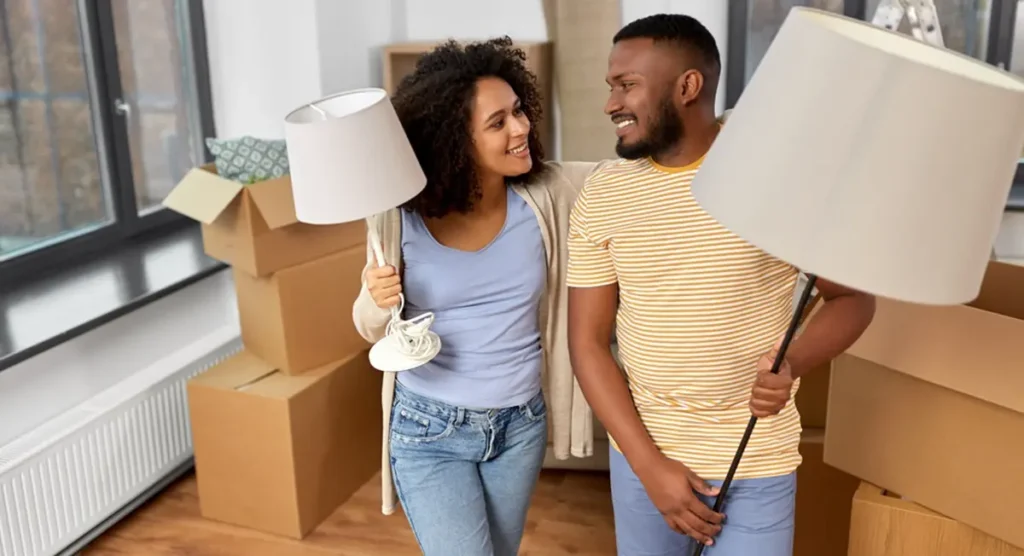As you know, packing fragile items is are hard task and lamps are also in this category. So, if you are getting started to move or tackling an interstate one, it is most important to know how to pack a lamp properly before moving.
Lamps come in unique shapes, sizes, and materials, and it is also very important to handle them because they need extra care, especially when they are made of Ceramic or glass-based materials.
Lamps come in various editions and give your home a perfect look, and can also be a stylish touch. As you know that this item needs more attention when packing it. That’s why in this blog, we provide you with important tips for packing a lamp when you move.

Why Properly Packing a Lamp is Important
Lamps not only illuminate our homes and offices; they also represent our style, taste and sometimes our individuality. Some were semi-custom to represent a period in history and lose historical significance. These aspects give lamps not only their aesthetic value, but also their emotional value. They have characteristics making them unique, such as designs and functional aspects. Physically, however, the particulars of the lamps mean they can be sensitive to transport and movement. Learning the particulars of lamps helps understand the importance of safely packing them.
- Components: The lamp itself is a compilation of components like glass globes and finials that are fragile; the downward motion of the reassured base can result in reversing the overall purpose of packing the lamp safely to keep the vibrancy of the new comfortable zone.
- Value: Some lamps can even be classified as an investment, especially designer lamps, while other lamps are emotional anchors of special events in lives or reminders of special people.
- More than Decor: Lamps are most definitely more than a pretty thing to look at; lamps are space illuminators, and convenient light sources for daily life to be performed. Therefore, it is important to safely transport them to be able to preserve the feeling and condition of home in transition.
- Unusual Designs: The lamp category includes an array of lamps, such as floor and table lamps, which bring their own packing idiosyncrasies, which is amazing.
Tips for Packing a Lamp
As you know that lamps require a systematic approach to preparation. Mentioned below we provide you the tips for packing a lamp:
Unplug the Lamp
When you are preparing to move, make sure that you secure your delicate items like lamps. Here we provide you with why unplugging the lamp is important:
- Electrical Hazards: Unplugging eliminates the risk of electrocution during deconstruction.
- Keep That Cord Nice: When you’re finished unplugging, wind the cord up nicely to avoid tangling or ripping. You can employ a tie-twist or a rubber band to keep it orderly.
- Avoid Incidents: Try not to move your lamp and have it come crashing down because the cord is caught on something. Unplugging can help you avoid these minor inconveniences.
- Take a Break: All gadgets, including lamps, need to take a break now and again. A continuous connection can cause stress on these devices. Unplugging means they will be delivery-ready in their new location.
Detach the Lampshade
To preserve the shape of the lampshade, the lampshades are typically made of materials such as glass, paper, or cloth. All of which can be subject to shattering, tearing, and denting.
- Find out where the Finial is: The fancy screw that holds the lampshade in place on most lamps is known as a finial. It is usually located at the top of the lampshade.
- Remove the finial gently: To remove the finial, turn it in a counter-clockwise pattern. Remove the lampshade from the base slowly after you have removed the finial.
- Look for other attachments: Some lampshades may be able to remove various clips or other attachments. Before putting the shade away, make sure everything is detached.
- Store it: Store the lampshade where it is unlikely to be crushed or broken. If possible, wrap the lampshade in some packing paper or bubble wrap before it goes into storage.
Clean and Dust
Moving can be such a great chance for a fresh start, and this can apply to your items too! A quick cleaning of your lamp will make sure it’s ready to shine in its new home:
- Base Cleaning: Using a soft cloth, wipe the base of the lamp to clear any dust or dirt that has accumulated.
- Lampshade Cleaning: For fabric shades, a lint roller is the perfect choice for cleaning any zoning or dust! For glass or plastic shades, a quick wipe with a damp cloth will help remove any fingerprints or smudges and help the shade shine again!
- Give the cord a once-over: While you’re at it, take a quick look at the lamp’s cord. If it is dirty or dusty, a quick wipe may just brighten things up. Not only does this look great, it can help with safety too.
- Blub Brightness: If you remove the bulb, be sure to give it a gentle wipe too! A clean bulb will give a clearer and brighter light!
Wrapping Up
In the above details, we give you proper information about how to pack a lamp for moving. We hope that this information will help you to properly pack the lamp when you move to your new home.
FAQs
Q: Is it okay to pack a lamp on its side in a moving box, or does it need to be up?
A: No, it’s not okay you can do is place the lamp base upright in the box. Firstly, tape the plastic bag and then disassemble the lamp and put it inside the box in the correct form. Fill the gaps with tape and seal the box.
Q: How to pack lanterns for moving?
A: I like carefully the lamp bodies in a plate pack after wrapping paper. First, place a cushion of curled gasket paper on the bottom. Then hold the wrapped lamps straight, around them with curled paper or a pillow to fill them.
Q: How do I add weight to a lamp?
A: Let’s look at some effective techniques to put weight and stability in the floor light.
- Use lamp base weight. The lamp weight is specially designed to support unstable lights.
- Fill the base with sand or gravel.
- Install a heavy base or plywood. Attach the lamp to the floor.
- Adjust the leveling legs.
- Use a lamp stabilizer or grip.




